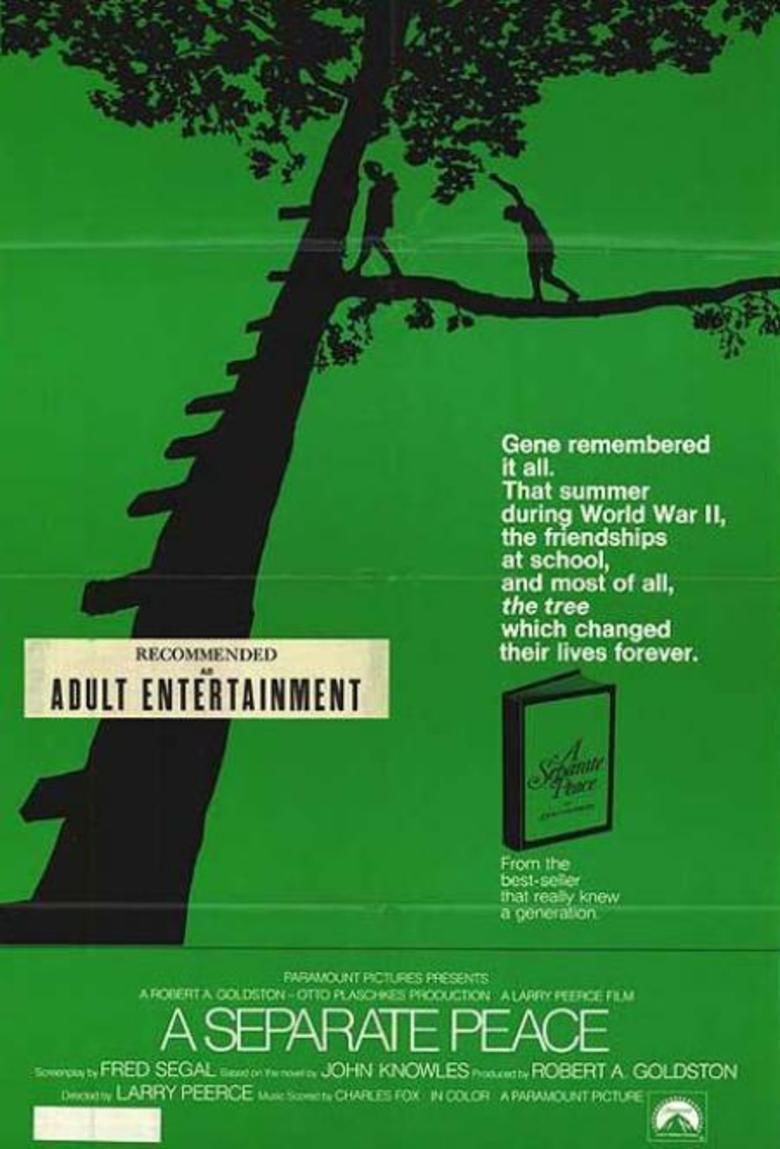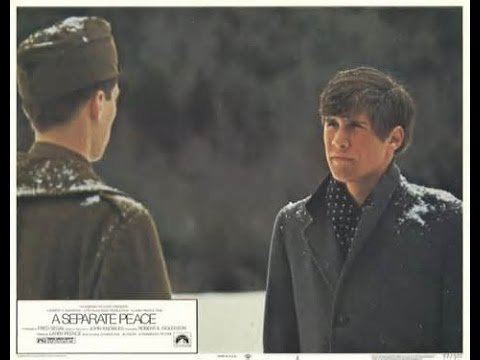A Separate Peace (film)
5.4 /10 1 Votes
Duration Country United Kingdom | 5.2/10 IMDb Genre Drama Language English | |||||||||||||||||||||||||||||||||
 | ||||||||||||||||||||||||||||||||||
Release date 1972 Similar movies Related Larry Peerce movies | ||||||||||||||||||||||||||||||||||
A separate peace 2004 movie
A Separate Peace is a 1972 American drama film directed by Larry Peerce. It was adapted by John Knowles and Fred Segal (brother of actor George), from the former's best-selling novel of the same name. It starred Parker Stevenson, who would later rise to fame as Frank Hardy on The Hardy Boys/Nancy Drew Mysteries, and as "Craig Pomeroy" on Baywatch.
Contents
- A separate peace 2004 movie
- A separate peace train scene
- Plot
- Cast
- Reception
- A separate peace trailer
- References

A separate peace train scene
Plot
During the summer of 1942, sixteen-year-old Gene Forrester attends Devon School, a private New England Academy. His roommate is Phineas, a free-spirited and cheerful nonconformist who is loved by everyone he meets. Gene, an introvert, tries to stifle his growing jealousy but is unable to control his envy of Finny’s athletic skill, natural popularity, and above all his innate goodness. Finally, unable to bear the knowledge that Finny is a better person, Gene apparently shakes the branch of a tree overhanging a river in the film (and novel)’s centerpiece sequence that causes the normally agile Finny to fall to the ground, breaking his leg and turning him into a cripple. After the accident, Gene meets with Finny and attempts to confess, but he then realizes that Finny desperately needs the illusion of friendship and he needs to boost his fallen friend’s self-confidence.
When Finny returns for the winter semester after recovering (but his own athletic career is finished) he refuses to accept the wartime influences that permeate Devon and commences to train Gene for the Olympics. Finny is initially resistant to the fact that a war is raging around them, until another student, “Leper” Lepelier returns AWOL and corroborates the horrible stories that up until then have never been informed by first-person narrative. Another student, the judicious-minded Brinker Hadley instigates an inquiry into Finny’s accident and convenes a kangaroo court of fellow students on a small second-floor meeting room on campus, at which point Leper reveals the truth about what happened, as he was looking up from under the tree when Gene supposedly shook the branch. Finny begins to cry and in his effort to escape the tribunal, he falls down the stairs and breaks his leg again. The second disaster has a curious healing effect on both boys, and when Gene visits Finny in the infirmary, the two are reconciled as Finny accepts the fact that Gene never meant to hurt him, and Gene reveals that Finny would have been emotionally unfit for war anyway. However, during a second operation on his leg, Finny dies after bone marrow gets into his bloodstream during the procedure and travels to his heart. The surgeon tells a shell-shocked Gene “there are risks, always risks” and then the surviving boy realizes a part of him has died with the death of his best friend.
Cast
Reception
Vincent Canby of The New York Times was impressed: "Larry Peerce's film version of A Separate Peace is so good and true in small, subsidiary details of costume, music, weather and such that the ultimate banality of what it's all about is just that much more apparent, and just that much more difficult to accept without seeming unnecessarily ill-tempered. ...Peerce is very good with his almost completely nonprofessional cast, especially with John Heyl, a stocky, handsome young man whose face reflects the profound cheerfulness of someone who' will never grow old. Parker Stevenson has the more difficult role (perhaps an impossible one) and I'm not sure I'd have had much idea of what was going on in his mind had I not read the book. As he displayed in Goodbye, Columbus, Peerce has a positive talent not only for period detail, but also for knowing when and how to cut around and away from the performances of non-actors so that Heyl, Stevenson and a large proportion of the Exeter student body manage to come up trumps."
Not so kind was film historian Leonard Maltin, who denounced the picture in his annual Movie and Video Guide: "This supposedly-sensitive story, from an overrated novel, is morbid enough to make anyone gag. The acting is incredibly amateurish, and the direction has no feeling at all for the period. A Total Bummer is more like it." The film did receive glowingly positive reviews from William Wolf in Cue Magazine, Wanda Hale in the New York Daily News and from Rex Reed, who was also at the time writing for the News. He called it "one of the best films about youth ever made" and added "I have seen the film three times, and I dare say I have more left in me."
A separate peace trailer
References
A Separate Peace (film) WikipediaA Separate Peace (film) IMDb A Separate Peace (film) themoviedb.org
